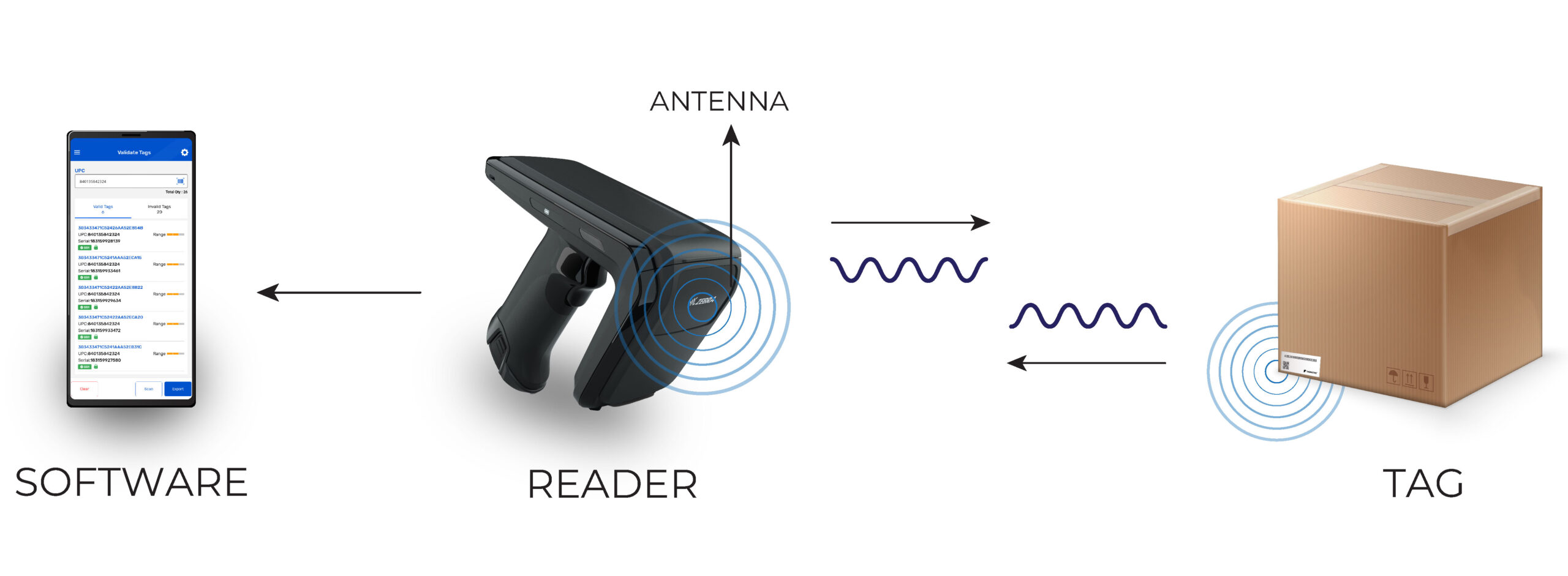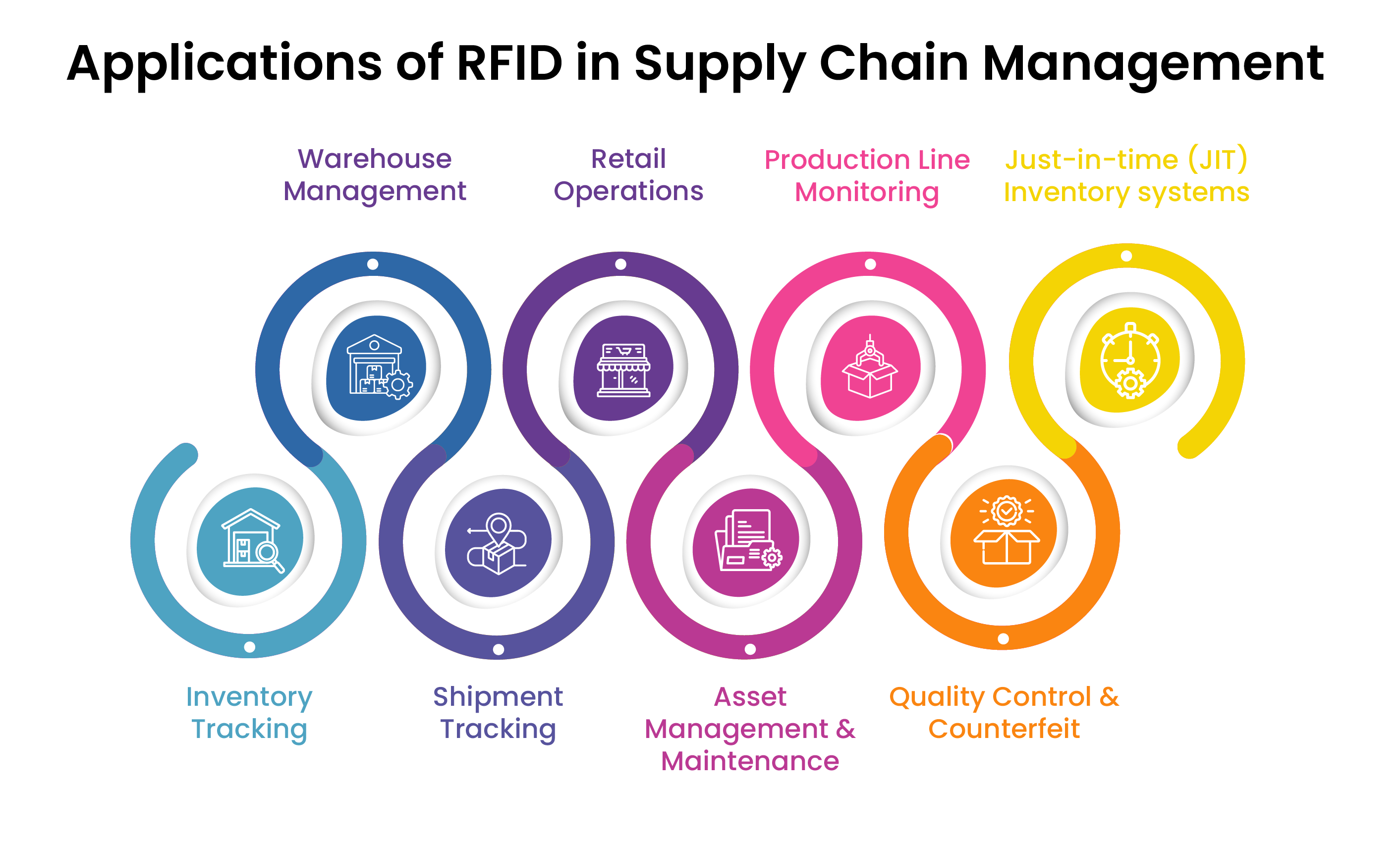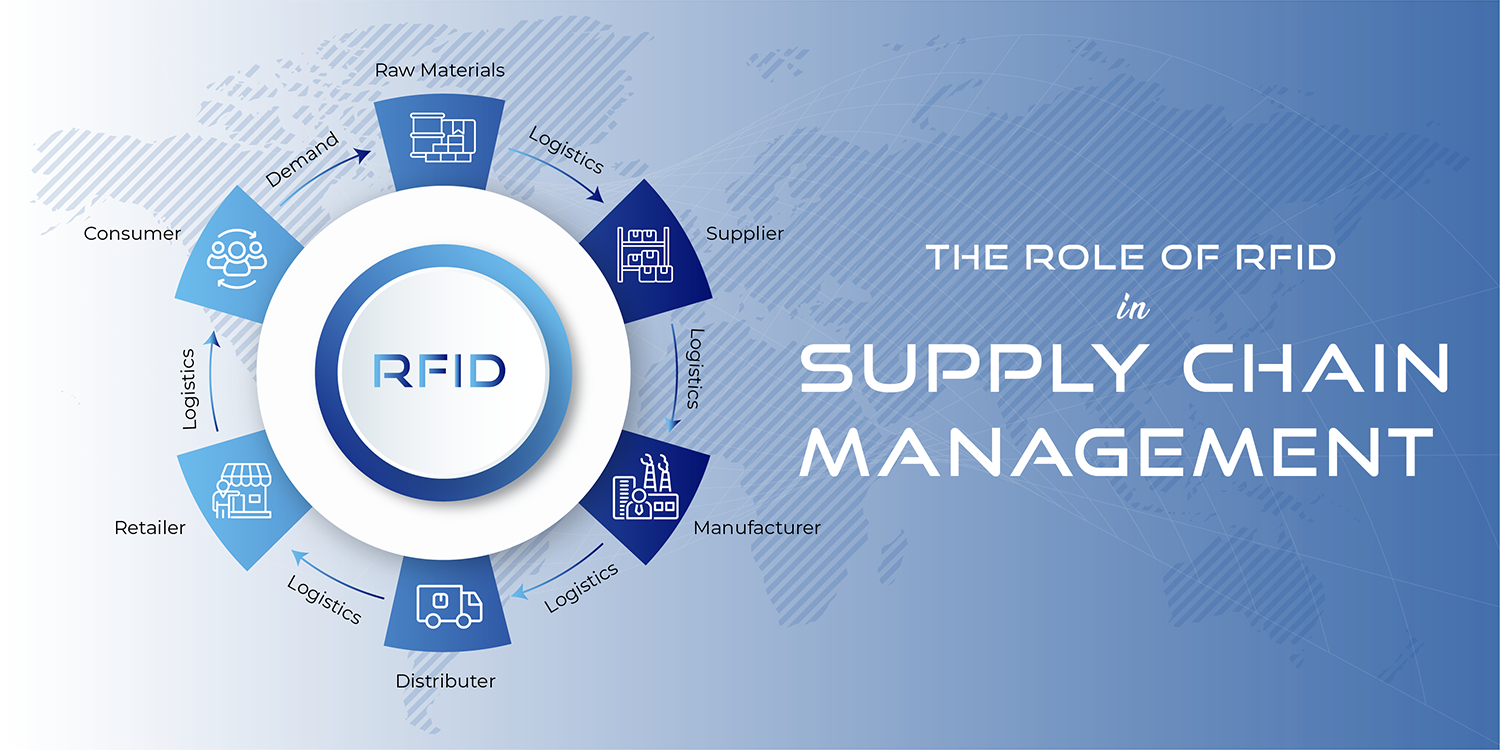In a fast-paced business world, efficient supply chain management is crucial for success. One technology that has revolutionized this field is Radio Frequency Identification (RFID). RFID tags in supply chain management have become increasingly popular due to their ability to streamline operations, improve accuracy, and provide real-time visibility. This blog post will explore the ins and outs of RFID technology and its significant impact on supply chain management.
What is RFID?
RFID stands for Radio Frequency Identification. It’s a technology that uses radio waves to identify and track objects.
The basic components of an RFID system include:
RFID tags
These are small electronic devices containing a microchip and an antenna. In supply chain management, RFID tags are attached to items, pallets, or containers. They store unique identification data and can be passive (powered by the reader’s signal) or active (battery-powered for a longer range).
RFID readers
Also known as interrogators, these devices emit radio waves and receive signals from RFID tags. In warehouses or distribution centers, fixed readers can be mounted on doorways or conveyor belts, while handheld readers offer mobility for inventory counts or locating specific items.
RFID software
This is the brain of the RFID system, processing and managing data collected by the readers. In supply chain applications, RFID software integrates with existing management systems to provide real-time inventory updates, automate order fulfillment, and generate insightful analytics for decision-making.
RFID Antenna
The antenna is a crucial component that enables communication between the RFID reader and tags. In supply chain settings, carefully positioned antennas ensure optimal read ranges and coverage areas, allowing for efficient tracking of goods as they move through warehouses, loading docks, and transportation hubs.
How RFID works in simple terms
Imagine you have a special sticker (the RFID tag) on an item. When this sticker comes close to a special scanner (the RFID reader), it wakes up and sends information about the item to the scanner. This happens without needing to see or touch the item, making it super quick and easy to track things.

RFID vs. Traditional Barcode Systems
Key differences
- Read range: RFID can read tags from a distance, while barcodes need line-of-sight scanning.
- Data capacity: RFID tags can store more information than barcodes.
- Simultaneous scanning: RFID can read multiple tags at once, and barcodes are scanned one at a time.
- Durability: RFID tags are more resistant to environmental factors than printed barcodes.
- Security: RFID offers enhanced security features compared to barcodes.
Advantages of RFID
- Faster data collection
- Improved accuracy
- Greater flexibility in tag placement
- Ability to update information on the tag
Applications of RFID in Supply Chain Management
RFID tags in supply chain management have numerous applications:

Inventory tracking
RFID technology enables automatic, real-time inventory counts without manual intervention. This reduces human errors, saves time, and provides accurate stock levels, allowing businesses to optimize inventory management and avoid stock outs or overstock situations.
Warehouse management
RFID streamlines warehouse operations by quickly locating items, optimizing storage space utilization, and improving picking efficiency. It enables automated tracking of goods movement, reducing search times and enhancing overall warehouse productivity and accuracy.
Shipment tracking
RFID tags on shipments provide real-time location data throughout the transit process. This improves delivery accuracy, enables proactive problem-solving for delays, and enhances customer satisfaction through precise delivery time estimates and increased transparency.
Retail operations
In retail, RFID enabled smart shelves automatically detect low stock, facilitate automated checkouts, reduce queue times, and improve inventory management. This leads to better product availability, reduced shrinkage, and enhanced customer experience in stores.
Asset management and maintenance
RFID helps businesses track and manage valuable assets efficiently. It enables automatic scheduling of maintenance based on usage, reduces equipment downtime through predictive maintenance, and provides accurate asset location information, improving overall operational efficiency.
Production line monitoring
RFID tags track components and products throughout the manufacturing process, ensuring quality control at each stage. This enables real-time production monitoring, helps identify bottlenecks, and improves overall manufacturing efficiency and product quality.
Just-in-time (JIT) inventory systems
RFID technology supports JIT systems by providing accurate, real-time inventory data. This enables more precise demand forecasting and automated inventory replenishment, reducing holding costs and supporting lean manufacturing principles for improved operational efficiency.
Benefits of RFID in Supply Chain Management
Improved accuracy
RFID significantly reduces human errors in data entry and inventory counts. Automating these processes, it provides more reliable and up-to-date information, leading to better decision-making and reduced discrepancies in supply chain operations.
Real-time visibility
RFID enables continuous, real-time tracking of items throughout the supply chain. This enhanced visibility allows businesses to make informed decisions quickly, respond to issues proactively, and optimize their supply chain processes for improved efficiency.
Reduced labor costs
By automating data collection and inventory processes, RFID significantly reduces the need for manual labor in these areas. This leads to substantial cost savings, and improved productivity, and allows staff to focus on more value-added tasks within the supply chain.
Enhanced security
RFID tags can incorporate advanced security features to prevent theft and counterfeiting. This protects valuable assets and products throughout the supply chain, reducing losses and ensuring authenticity, which is crucial for high-value or sensitive goods.
Challenges and Solutions
Implementation costs
Initial investment in RFID technology can be high, including hardware, software, and integration expenses. We offer scalable solutions and flexible pricing models, allowing businesses to start small and expand as needed. We also provide ROI analysis to demonstrate long-term cost savings and efficiency gains.
Technical limitations
RFID signals can be affected by metal and liquids, and interference from other radio frequencies can occur. RFID4U utilizes advanced tag designs and reader configurations optimized for challenging environments. We conduct thorough site surveys to identify potential interference sources and implement strategic reader placement to maximize read accuracy.
Future of RFID in Supply Chain Management
The future of RFID in supply chain management looks promising, with ongoing advancements in technology. We can expect:
- Integration with Internet of Things (IoT) devices for even greater connectivity.
- Improved tag designs with longer read ranges and better performance.
- Enhanced data analytics capabilities to derive more value from RFID data.
- Increased adoption across industries as costs decrease and benefits become more apparent.
RFID Software for Supply Chain Management
TagMatiks AT is a cloud-based RFID asset tracking software that offers powerful solutions for supply chain management. This software provides:
TagMatiks AT helps businesses leverage the full potential of RFID technology, turning data into actionable insights and improving overall supply chain efficiency.
- Real-time asset visibility across multiple locations
- Customizable dashboards for easy data interpretation
- Automated alerts and notifications for inventory levels and asset movement
- Integration capabilities with existing ERP and WMS systems
- Advanced reporting features for better decision-making
Conclusion
RFID tags in supply chain management have transformed the way businesses track and manage their inventory and assets. From improving accuracy and visibility to reducing costs and enhancing security, RFID technology offers significant benefits across the supply chain. While challenges exist, the continued advancement of RFID technology and software solutions like TagMatiks AT is making implementation more accessible and valuable for businesses of all sizes. As we move into the future, RFID will undoubtedly play an increasingly crucial role in creating more efficient, responsive, and intelligent supply chains.
